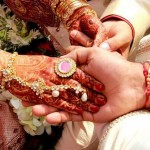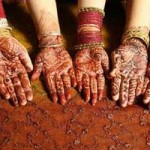The Most popular of the Balinese People is Hindu. Hinduism in Bali is a great historical relics of the Majapahit Kingdom, where the entire Indonesian region and parts of Southeast Asia is owned by The Kingdom of Majapahit, one of the largest Hindu Kingdom in southeast Asia .
Hinduism itself born and first appeared in India, precisely the Nil River. This makes India the Hindu religion most populous. Indian people themselves not only in India, decades or even hundreds of years the population of Indian descent has spread throughout the world. Which became the most special thing is no matter where they live Indians will always retain their traditions and identity very well. It is manifest from the way Indians in implementing the ordinance of marriage. Whole series of Hindu India Wedding as Mehendi ceremony or party Hena , Ghari , Sangeet , Mandap or wedding , reception will be held exactly like the original Indian traditions.
Punjabi Wedding Ceremony
The Punjabis, known for their zest for life, vivaciousness and of course, the bhangra, know how to pull all stops when it comes to celebrating. And what better occasion to celebrate than a wedding in the family?
Roka
As soon as the couple agree to wed, the roka or saith ceremony, which is an announcement that the boy and girl have found their soulmates and will look no further for a life partner, is held. The girl’s mama (mother’s brother) gives her the nath (nose ring) which she will wear on her wedding. The origin of this ceremony lies in the arranged marriage norm where the parents would let out the world that they are looking for a suitable match for their son or daughter. And once they had found that match, their search had come to an end. Though rings are not exchanged, the couple stand unofficially engaged after this ceremony.
Sagai
The wedding celebrations begin with the tikka ceremony, held a week to ten days before the wedding (depending on the number of functions to follow) in which the family of the girl visits that of the boy’s carrying beautifully wrapped gifts and the tikka material: a silver tray with a few grains of rice and saffron in a tiny silver bowl, 14 chuharey (dried dates) covered with silver foil and a coconut wrapped in a gold leaf. The father of the girl applies ‘tikka’ on his son-in-law’s forehead and gives him his blessings and some money. In return, the girl’s family receives baskets of seven dried fruits: almonds, cashewnuts, chuahara, coconut pieces, raisins, khurman (dried apricots) and phoolmakhana, at the kudmai (sagai or engagement). Nowadays the tikka ceremony is usually combined with the engagement. First, the girl is draped with a chunni (stole), which is usually very ornate. In some families this chunni is a family heirloom, passed down from generation to generation. She is also presented with jewellery, which her mother and sister-in-law help her wear. A tiny dot of mehendi is applied to her palm for good luck, and the function is sealed with the exchange of rings. Everyone present congratulates the couple by feeding them sweet.
Sangeet
After this function start the fun and dance. There is a sangeet function hosted by the girl’s family, in which just a few close members of the boy’s family are invited. The girl’s family play the dholki (an elongated tabla) sing songs in which they tease the boy and his family, telling them to thank their stars they were lucky to find such a wonderful girl. who they probably didn’t deserve! All in jest, of course, but they take care not to get carried away. After this, it is the boy’s turn to retaliate, which they do in another sangeet function hosted by them. Though these are the traditional sangeets, many families opt for live bands or a disc jockey to churn out one dance track after another as guests shake a leg on the floor.
Mehendi
The last major function before the wedding is the mehendi. Mehendiwallis are called to the respective houses of the boy and girl and they apply mehendi to the palms of the female family members, and the hands and feet of the bride. A basket containing bindis and bangles is handed around so girls can choose those that match the outfit they plan to wear to the wedding.
The Final Countdown
The maaiyan of the bride starts three days before the wedding, which means she is now not supposed to leave the house until the big day. These days are meant for complete relaxation. She is not even supposed to meet the groom (if he can stay away!). The morning of the wedding, batna, a paste of flour and turmeric, is applied to the face, hands and legs of the bride. This is believed to beautify the skin. She then has a bath and sits for the puja, after which she is made to wear the bridal ‘chura’, red and white ivory bangles that signify her status as a bride. Her relatives then tie a kalira (jingle) on these churas, which convey their good wishes and blessings. The eligible girls line up and the bride lightly bangs her kaliras on their head. It is believed that by doing this, these girls would be the next to get married.
Similarly the groom’s relatives also apply batna, more as a jest than a serious ceremony. This is followed by a puja, after which his mother ties a sehera (veil of flowers) on his turban, praying that his life ahead will be as beautiful and fragrant as the flowers. (And if the groom is ugly, the more of his face covered, the better!) He is then seated on a female horse and his sisters tie a mauli (sacred thread) on the reins of his horse. They also detain the horse in the tradition known as baagpakdai, saying that they won’t leave it’s reins unless their brother bribes them. Once they are satisfied with the cash or jewellery bribe, they release the reins so the groom can gallop off to fetch his bride.
At The Venue
The bride’s family waits at the entrance to greet the baarat (the groom and his family), who reach singing and dancing. The father, brother, uncles and grandfathers of the groom embrace the corresponding members of the bride’s family. While embracing, they try to lift each other up. as a show of strength and superiority, amidst much laughter and cheer. When they enter the venue the bride is brought out and the couple exchange garlands. The groom, who is usually taller than the bride, is not supposed to bend while she is garlanding him, to tease the bride as if to say she is the one who would have to compromise in the relationship; he will not bend. Another game played is by placing a ring in a plate filled with milk. The bride and groom dip their hands in the plate and the one who comes out with the ring will dominate in the marriage.
The wedding concludes with the pheras, where the couple exchange vows in front of the sacred fire. The bride’s parents give her hand to the groom in marriage in what is known as the kanyadaan. In the earlier days, in exchange for the bride, her in-laws would donate a sacred cow (gaudaan)! Nowadays money says it all, and a donation is given to the pundit. The couple take four rounds of the fire, and seven steps to the North to signify advancement as they walk together through life. Then the bride puts a foot on a stone as she says no matter what problems come their way, she will be stable – solid as a rock. Her brother pours kheel (a sweet) into her hands, which she pours into her husband’s hands. Just as the kheel cannot return to it’s original state of grain, neither can the bride return to her earlier state of daughter of the house.
Once this is done the boy’s father sprinkles water on the newly-weds to say that if there are misunderstandings between them, he will help calm them down – not add fuel to the fire. The bride then makes a tearful farewell to her new home in what is known as the ‘bidai’. Traditionally she would sit in a doli (palanquin) which would be carried by the bride’s brothers. Even now some brides sit in a doli, which takes her to the getaway car, where the groom and a few members of his family are waiting to escort her home. She gets in, and zooms off to her new home – and new life.
- Sindhi Wedding Bali
- Mehndi Henna Hands Bali
SINDHI WEDDING CEREMONY:
A Sindhi wedding ceremony is not too different from a Hindu Indian wedding ritual. It differs from a typical Hindu wedding because of its pre and post wedding rituals. The Mehraj, namely the sindhi priest, first performs the kachi misri, which is the informal engagement ceremony. Following that, if a male has not had Janya performed as a young adult, the scared thread ceremony is performed before the wedding. As the wedding approaches, Sindhi perform a prayer to Jhulelal, called the Behrana to ask the Sindhi God to bless the couple’s life. Following Bherena, ladas are sung, mehendi is applied and satt surn and ghari Bukhi ceremony is performed at the bride and groom’s house separately. Vanwa: oil and haldi ceremony. Sagri takes place at the bride’s house as the groom gets ready.
The wedding ceremony is performed with traditional Sindhi rituals and the ceremonies consists of the following steps: 1. Swagatam (welcome of the baarat) 2. Hathialo (joining of the couple hands) 3. Ganesh Poojan 4. Nav Grah Poojan (prayer of the nine planets) 5. Kalash Poojan (prayer to the lord of water) 6. Vidi (reading of mantras from holy books) 7. Havan (holy fire) 8. Mangal Phera (walk around the fire) 9. Saptapadi (seven steps together) 9. Promises 10. Varmala (garland exchange) 11. Wedding ring 12. Mangal sutra (scared necklace) 13. Kanyadhan (sent off the bride) 14. Mithai khilana (sweet offerings) 15. Senan ji gadjani (meeting of the groom and brides parents) 16. Palav (blessings for everyone) 17. Ashirvad and Shanti Path (blessings and sent off).
The wedding ends by performing the datar assures that all the rituals in a Sindhi wedding are performed most traditionally by the bride and groom. Weddings are meant to be fun and our Sindhi Mehraj understands that completely and ensures everyone has a good time at the wedding and all the pre and post wedding rituals.
Bali Grace Wedding, ready to make whole series of ceremonies and Indian Hindu wedding in Bali. We are also able to provide Indian Hindu priest who fully understand the procedure and prayer Indian Hindu wedding ceremony as Agni Hotra in Mandap. In some cases the Indian wedding is also different in kind such as Punjabi or Sindhi Wedding Wedding, and much more.
Please contact us for further information



